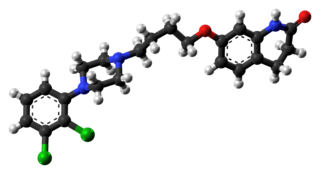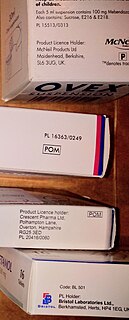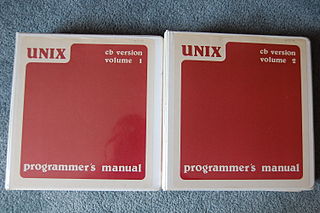
Antipsychotics, also known as neuroleptics or major tranquilizers, are a class of medication primarily used to manage psychosis, principally in schizophrenia and bipolar disorder. They are increasingly being used in the management of non-psychotic disorders but with serious side effects. Antipsychotics are usually effective in relieving symptoms of psychosis in the short term.

Paroxetine, sold under the brand names Paxil and Seroxat among others, is an antidepressant of the selective serotonin reuptake inhibitor (SSRI) class. It is used to treat major depressive disorder, obsessive-compulsive disorder, panic disorder, social anxiety disorder, posttraumatic stress disorder, generalized anxiety disorder and premenstrual dysphoric disorder. It has also been used in the treatment of hot flashes due to menopause and premature ejaculation. It is taken by mouth.

Ziprasidone, sold under the brand name Geodon among others, is an atypical antipsychotic that is used for the treatment of schizophrenia as well as acute mania and mixed states associated with bipolar disorder. Its immediate release intramuscular injection form is approved for acute agitation in people with schizophrenia. Ziprasidone is also used off-label for depression, bipolar maintenance, and post-traumatic stress disorder (PTSD).
Clinical trials are experiments or observations done in clinical research. Such prospective biomedical or behavioral research studies on human participants are designed to answer specific questions about biomedical or behavioral interventions, including new treatments and known interventions that warrant further study and comparison. Clinical trials generate data on safety and efficacy. They are conducted only after they have received health authority/ethics committee approval in the country where approval of the therapy is sought. These authorities are responsible for vetting the risk/benefit ratio of the trial – their approval does not mean that the therapy is 'safe' or effective, only that the trial may be conducted.

Topiramate, sold under the brand name Topamax among others, is a medication used to treat epilepsy and prevent migraines. It has also been used in alcohol dependence. For epilepsy this includes with generalized or focal seizures. It is taken by mouth.

Thioridazine is a piperidine typical antipsychotic drug belonging to the phenothiazine drug group and was previously widely used in the treatment of schizophrenia and psychosis. The branded product was withdrawn worldwide in 2005 because it caused severe cardiac arrhythmias. However, generic versions are still available in the US.

Aripiprazole, sold under the brand name Abilify among others, is an atypical antipsychotic. It is primarily used in the treatment of schizophrenia and bipolar disorder. Other uses include as an add-on treatment in major depressive disorder, tic disorders, and irritability associated with autism. A Cochrane review found evidence in schizophrenia not sufficient to determine effects on general functioning. Additionally, as many people dropped out of the studies before they were completed, the strength of the conclusions was low. It is taken by mouth or injection into a muscle.

A prescription drug is a pharmaceutical drug that legally requires a medical prescription to be dispensed. In contrast, over-the-counter drugs can be obtained without a prescription. The reason for this difference in substance control is the potential scope of misuse, from drug abuse to practicing medicine without a license and without sufficient education. Different jurisdictions have different definitions of what constitutes a prescription drug.

Gabapentin, sold under the brand name Neurontin among others, is an anticonvulsant medication used to treat partial seizures, neuropathic pain, hot flashes, and restless legs syndrome. It is recommended as one of a number of first-line medications for the treatment of neuropathic pain caused by diabetic neuropathy, postherpetic neuralgia, and central neuropathic pain. About 15% of those given gabapentin for diabetic neuropathy or postherpetic neuralgia have a measurable benefit. Gabapentin is taken by mouth.
Cheminformatics is the use of computer and informational techniques applied to a range of problems in the field of chemistry. These in silico techniques are used, for example, in pharmaceutical companies and academic settings in the process of drug discovery. These methods can also be used in chemical and allied industries in various other forms.

Drug design, often referred to as rational drug design or simply rational design, is the inventive process of finding new medications based on the knowledge of a biological target. The drug is most commonly an organic small molecule that activates or inhibits the function of a biomolecule such as a protein, which in turn results in a therapeutic benefit to the patient. In the most basic sense, drug design involves the design of molecules that are complementary in shape and charge to the biomolecular target with which they interact and therefore will bind to it. Drug design frequently but not necessarily relies on computer modeling techniques. This type of modeling is sometimes referred to as computer-aided drug design. Finally, drug design that relies on the knowledge of the three-dimensional structure of the biomolecular target is known as structure-based drug design. In addition to small molecules, biopharmaceuticals including peptides and especially therapeutic antibodies are an increasingly important class of drugs and computational methods for improving the affinity, selectivity, and stability of these protein-based therapeutics have also been developed.
Nootropics are drugs, supplements, and other substances that may improve cognitive function, particularly executive functions, memory, creativity, or motivation, in healthy individuals. While many substances are purported to improve cognition, research is at a preliminary stage as of 2019, and the effects of the majority of these agents are not fully determined.

Bromazepam, sold under many brand names, is a benzodiazepine. It is mainly an anti-anxiety agent with similar side effects to diazepam (Valium). In addition to being used to treat anxiety or panic states, bromazepam may be used as a premedicant prior to minor surgery. Bromazepam typically comes in doses of 3 mg and 6 mg tablets.
A biological target is anything within a living organism to which some other entity is directed and/or binds, resulting in a change in its behavior or function. Examples of common classes of biological targets are proteins and nucleic acids. The definition is context-dependent, and can refer to the biological target of a pharmacologically active drug compound, the receptor target of a hormone, or some other target of an external stimulus. Biological targets are most commonly proteins such as enzymes, ion channels, and receptors.

CX717 is an ampakine compound created by Christopher Marrs and Gary Rogers in 1996 at Cortex Pharmaceuticals. It affects the neurotransmitter glutamate, with trials showing the drug improves cognitive functioning and memory.

Nabiximols is a specific extract of Cannabis that was approved as a botanical drug in the United Kingdom in 2010 as a mouth spray to alleviate neuropathic pain, spasticity, overactive bladder, and other symptoms of multiple sclerosis; it was developed by the UK company GW Pharmaceuticals. The drug is a pharmaceutical product standardised in composition, formulation, and dose. Its principal active cannabinoid components are the cannabinoids: tetrahydrocannabinol (THC) and cannabidiol (CBD). Each spray delivers a dose of 2.7 mg THC and 2.5 mg CBD.

Flibanserin, sold under the trade name Addyi, is a medication approved for the treatment of pre-menopausal women with hypoactive sexual desire disorder (HSDD). The medication increases the number of satisfying sexual events per month by about one half over placebo from a starting point of about two to three. The certainty of the estimate is low. The side effects of dizziness, sleepiness, and nausea occur about three to four times more often.

Adapromine is an antiviral drug of the adamantane group related to amantadine (1-aminoadamantane), rimantadine, and memantine (1-amino-3,5-dimethyladamantane) that is marketed in Russia for the treatment and prevention of influenza. It is an alkyl analogue of rimantadine and is similar to rimantadine in its antiviral activity but possesses a broader spectrum of action, being effective against influenza viruses of both type A and B. Strains of type A influenza virus with resistance to adapromine and rimantadine and the related drug deitiforine were encountered in Mongolia and the Soviet Union in the 1980s.

The Pharma Documentation Ring (P-D-R), founded in 1958, is a think tank of information and knowledge-management professionals representing major research-based pharmaceutical companies. The association has 4 aims:
EMDEX is the most commonly used reference source of drug and therapeutic information by healthcare professionals in Nigeria. It was first published in 1991 as Nigeria's Essential Drugs (NED) Guide.
EMDEX drug information contents, arrangements and therapeutic recommendations are supported by several references and clinical guidelines notably WHO Model Formulary, WHO ATC Classification System, Nigeria's Essential Medicines List and Standard Treatment Guidelines, etc. The information is regularly reviewed and updated by a select team of healthcare practitioners and academics.
The central objective of EMDEX has been to promote rational use of medicines through provision of independent drug information, and use of clinical guidelines and essential medicines list. It is the largest and up-to-date source of information on drug products approved for use in Nigeria by NAFDAC .
The use of EMDEX as a reference drug manual is endorsed by Pharmacists Council of Nigeria, Nursing & Midwifery Council of Nigeria and major health institutions. It is used both within and outside Nigeria by physicians, dentists, pharmacists, nurse practitioners, and auxiliary health workers at all levels of healthcare delivery. These healthcare providers rely on EMDEX for accuracy and completeness of drug information namely indications, contra-indications, precautions or warnings, adverse effects, dosages, and drug use in special populations like children, elderly, pregnancy & lactation.
EMDEX publications are also in the syllabus of various colleges & schools of medicine, pharmacy & nursing.

















